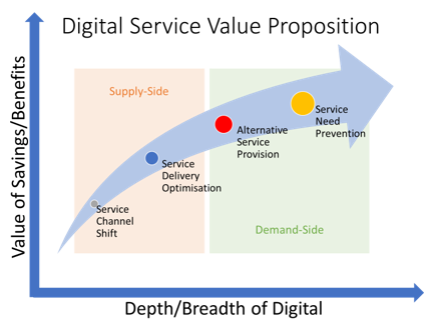Why Is Digital Right For You?
Going digital allows services, whether public facing or internal, to provide more customer-focused service benefit while saving on service cost.
More For Less
Digital transformation frees resources from many routine tasks, which can mean more resource time for other valuable tasks, and/or cost savings by reducing the need for extra resources.
Digital transformation also enables new types and styles of service, with the aim of encouraging more timely and effective use of services to avoid more costly service demands further down the line.
Digital Value Curve
The extent of digital transformation determines the value to be gained, as is suggested in the figure above.
- Service Channel Shift - moving from traditional channels to digital ones should reduce service provider costs and increase service consumer convenience, thus raising value-for-money;
- Service Delivery Optimisation - greater service efficiency and effectiveness can generate more value-for-money, with reliable fulfilment reducing both rework and recourse to non-digital channels;
- Alternative Service Provision - taking advantage of the resources of other organisations and of individuals, through commissioning, partnering and self-service, offers still more value-for-money;
- Service Need Prevention - using insight into populations and individuals to predict future service need, and using stakeholder engagement to help prevent that need, together offer the maximum long-term benefit to stakeholders and the bottom line.
But moving up this value curve is not easy, especially if you want to work on all four segments at once. Building trust with your customers, staff and partners is crucial to this end.



